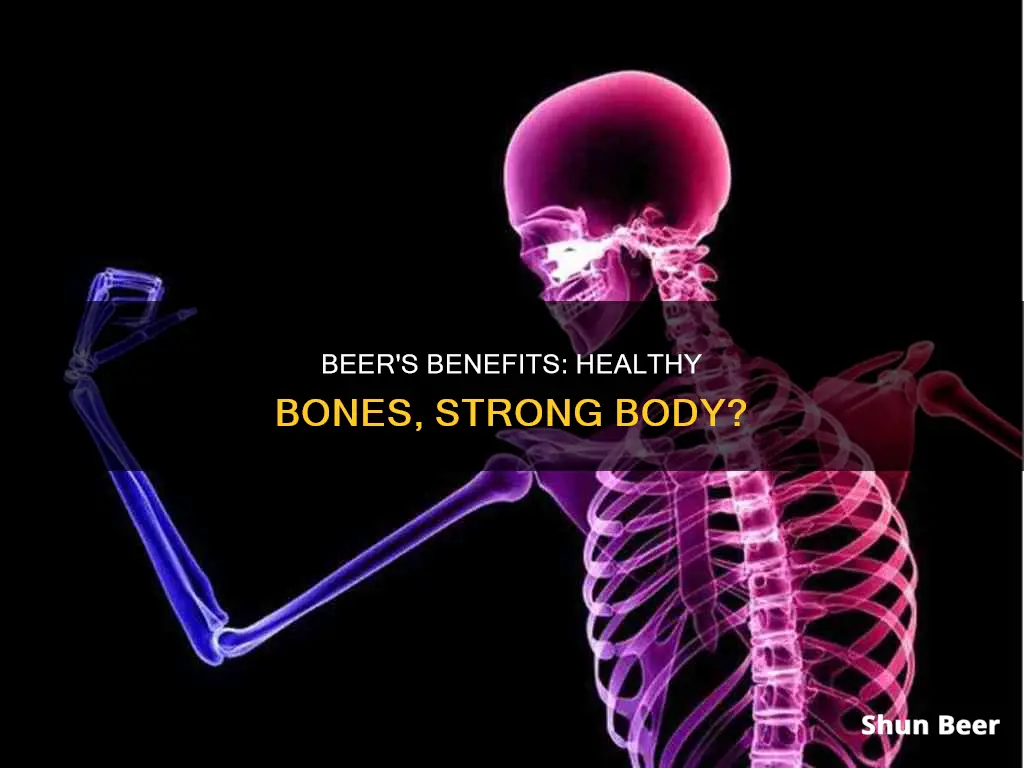
Beer has been linked to improved bone health in several studies. Moderate alcohol consumption, defined as a maximum of one drink per day for women and two drinks for men, has been associated with increased bone density and strength. This may be due to the silicon content in beer, which is a key ingredient for bone health. Silicon has been found to prevent bone loss and ward off osteoporosis. However, excessive alcohol consumption has been linked to bone loss and other negative health effects. Therefore, while beer may have some benefits for bone health, it is important to consume it in moderation.
| Characteristics | Values |
|---|---|
| Effect on bone density | Men consuming 1-2 alcoholic drinks/day had 2.5% to 5.3% greater BMD than non-consumers. |
| Postmenopausal women consuming >2 alcoholic drinks/day had 5.0% to 7.4% greater BMD than non-consumers. | |
| Men consuming >2 beers/day had lower BMD than those consuming 1-2 beers/day. | |
| Postmenopausal women consuming >2 beers/day had significantly greater BMD than non-consumers. | |
| Beer intake was associated with a significant increase in speed of sound transmission, suggesting an association with increased bone density. | |
| Silicon content | The silicon content of beer can range from 6.4 mg/L to 56.5 mg/L, with an average of 30 mg/L. |
| Beers containing the highest levels of malted barley and hops are the best sources of silicon. | |
| Pale ales have the highest levels of silicon, while non-alcoholic beers, light lagers, and wheat beers have the lowest amounts. |
What You'll Learn

Beer contains silicon, which is a key ingredient for bone health
Beer is a rich source of silicon, a key ingredient for bone health. Silicon has been found to prevent bone loss and help ward off osteoporosis. The silicon content of beer can range from 6.4 mg/L to 56.5 mg/L, with an average of 30 mg/L. Beers containing the highest levels of malted barley and hops are the best sources of silicon. Pale ales have the highest levels of silicon, while non-alcoholic beers, light lagers, and wheat beers have the lowest amounts.
A clinical study found that moderate beer consumption was associated with increased bone density and strength, likely due to several factors. However, excessive alcohol consumption has been linked to bone loss and other health complications. Therefore, it is important to drink beer in moderation to reap the potential benefits for bone health.
The positive effects of beer on bone health may be due to its high silicon content. Silicon is a micronutrient that has been suggested to prevent bone loss and improve bone density. A study by Tucker et al. found that moderate beer drinking of 1-2 beers per day was associated with increased bone density in men and women.
In addition to silicon, other factors may also contribute to the beneficial effects of beer on bone health. The ethanol in beer has a direct effect on inhibiting bone resorption. Additionally, the phytoestrogens and phytochemicals found in beer may also play a role in increasing bone density.
While beer may have some benefits for bone health, it is important to consume it in moderation as excessive alcohol consumption can have negative effects on overall health. The recommended limit is one drink per day for women and two drinks per day for men.
Beer and Kidney Health: Exploring the Connection
You may want to see also

Beer may help prevent osteoporosis
Several studies have found a positive association between beer consumption and bone mineral density, suggesting that beer may contribute to stronger bones. In one study of over 1,600 women, those who drank beer had higher bone density than non-drinkers, with a significant increase in speed of sound transmission through their bones. Another study of over 2,000 men and women found that moderate beer consumption of 1-2 beers per day was associated with increased bone density, especially in postmenopausal women.
The silicon content in beer is important for bone health. Silicon is a micronutrient that helps prevent bone loss and ward off osteoporosis. Beers containing the highest levels of malted barley and hops, such as pale ales, are the best sources of silicon. The University of California found that the silicon content of beer can range from 6.4 to 56.5 mg per liter, with an average of 30 mg per liter. This soluble form of silica found in beer is important for the growth and development of bone and connective tissue.
However, it is important to note that excessive alcohol consumption has been linked to bone loss and other health complications. Therefore, beer should be consumed in moderation as part of a healthy lifestyle.
Hard Liquor vs Beer: Which is the Healthier Choice?
You may want to see also

Excessive alcohol consumption can lead to bone loss
While moderate alcohol consumption may have beneficial effects on bone health, excessive alcohol intake can lead to bone loss. Chronic and heavy alcohol consumption is known to contribute to low bone mass, decreased bone formation, and an increased risk of fractures.
Heavy drinking, especially during adolescence and young adulthood, can negatively affect bone health and increase the risk of osteoporosis later in life. Alcohol interferes with the absorption of calcium and vitamin D, which are essential for healthy bones. It also disrupts the hormones important for bone health, such as estrogen, cortisol, and parathyroid hormone.
Additionally, excessive alcohol consumption can inhibit the formation and function of osteoblasts, which are new bone cells required for bone health and healing after bone injuries. The suppression of osteoblast development and function can lead to measurable bone loss over a few years.
Excessive alcohol intake can also increase the risk of falls and fractures, as it affects balance and can cause nerve damage. Therefore, it is important to drink in moderation to maintain bone health and reduce the risk of bone-related issues.
Hoppy Beers: Healthy or Hype?
You may want to see also

Beer contains phytoestrogens, which may be linked to increased bone density
Osteoporosis is a condition that causes bones to weaken and thin, increasing the risk of fractures. It is estimated that about 2 million fractures in the US each year are due to osteoporosis, with the bones of the spine, hip, and wrist being the most likely to break.
Although moderate alcohol consumption has been linked to beneficial effects on bone health, excessive drinking is detrimental. Research suggests that men who consume more than two drinks per day of liquor have significantly lower hip and spine bone mineral density (BMD) than those who consume one to two drinks per day.
In contrast, postmenopausal women who consume more than two drinks per day of total alcohol or wine have been found to have significantly greater hip and spine BMD than non-drinkers. However, it is important to note that excessive alcohol consumption is associated with an increased risk of falls and fractures, as well as other health risks such as breast cancer, heart disease, and cirrhosis.
Regarding phytoestrogens, there is limited scientific evidence on their effectiveness in increasing bone density. While some studies suggest that phytoestrogens may help prevent bone loss and improve bone health in menopausal women, others report conflicting results. The impact of phytoestrogens on bone health may depend on factors such as the number of oestrogen receptors and the endogenous hormone background.
Furthermore, the use of phytoestrogens has been associated with certain adverse effects, such as their potential role in uterine diseases and nonviral toxic hepatitis. The efficacy and long-term safety of phytoestrogens are also not well established, and they are not currently regulated by the Food and Drug Administration.
In conclusion, while beer contains phytoestrogens that may contribute to increased bone density, more research is needed to confirm their effectiveness and understand their potential adverse effects. It is important to note that excessive alcohol consumption can have negative consequences on bone health and overall health.
Two Beers a Night: Healthy Habit or Slow Poison?
You may want to see also

Beer may be especially beneficial for postmenopausal women
Another study by Pedrera-Zamorano et al. examined the beneficial effects of alcohol consumption on bone density in healthy women. The study found that age, BMI, and menopause were associated with significant decreases in sound transmission, but beer intake was associated with a significant increase in speed of sound transmission, suggesting an association with increased bone density. The authors of the study suggested that the greater bone density found in women beer drinkers might be due to the phytoestrogen content of beer.
Additionally, a study by Mukamal et al. reported a U-shaped curve for alcohol consumption and the risk of hip fracture. The study found that the risk of hip fracture decreased to 0.78 (95% confidence interval [CI], 0.61–1.00) among those who consumed up to 14 drinks per week compared to abstainers. However, those who consumed more than 14 drinks per week had an increased risk of fracture.
It is important to note that excessive alcohol consumption has been linked to bone loss and other health complications. Therefore, it is recommended to consume beer in moderation to reap the potential benefits for bone health.
Hard Seltzer vs Beer: Which Drink is Healthier?
You may want to see also
Frequently asked questions
Yes, beer can be healthy for your bones. Beer is a rich source of silicon, which is a key ingredient for bone health and can help prevent bone loss and osteoporosis.
It is recommended that you drink beer in moderation, with a maximum of one drink per day for women and two drinks per day for men. Excessive alcohol consumption has been linked to bone loss and other health complications.
Silicon is important for bone health because it is a micronutrient that can help prevent bone loss and ward off osteoporosis. It also has a high bioavailability, meaning that much of it is available for use in the body.
Beers containing high levels of malted barley and hops, such as Indian Pale Ales (IPAs), are the best sources of silicon. Wheat beers, light lagers, and non-alcoholic beers have lower amounts of silicon.







